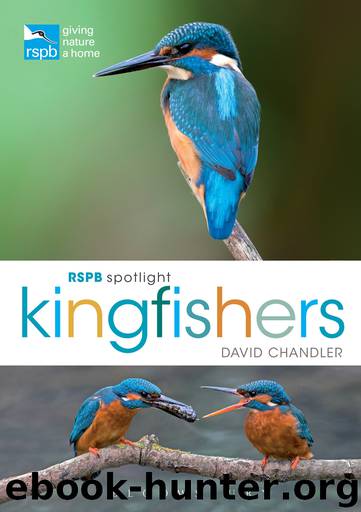RSPB Spotlight Kingfishers by David Chandler

Author:David Chandler
Language: eng
Format: epub
ISBN: 9781472933683
Publisher: Bloomsbury Publishing
Published: 2017-03-14T04:00:00+00:00
Top and bottom: Once early courtship is complete, male Kingfishers will present their partner with fish, perhaps several times a day.
Is monogamy the only way?
For the Kingfisher, monogamy is not the only way. Mostly they are monogamous, but not necessarily with the same partner from one year to the next. Where pairs are constant from year to year, and this is not unusual, it is likely to be two birds that carved up their breeding territory into two winter territories, with one territory for each bird.
It is also not unusual for a bird to change its mate from one year to the next, if, for example, an incomer has taken over their previous mate’s winter territory.
Polygamy is not the norm, but it is far from unheard of, with a typical polygamous relationship connecting two females to one male. Different studies have produced different figures for the incidence of polygamy, ranging from 6 per cent in a Swedish study by S. Svensson that looked at 116 ‘nesting associations’ to about 35 per cent on the Oka reserve in Russia (Numerov and Kotyukov, 1979). Occasionally, the polygamy involves three females, and in one of the Russian examples above, because the females were double-brooded, the male had his work cut out helping at six nests. Two females is more normal. The male may initiate proceedings with a second partner when the first is busy looking after eggs or brooding chicks. He might even abandon his first partner, leaving her with all of the hard work of raising the offspring. Sometimes both partners are at the same stage and the male incubates at one or both of the nests, leaving the remainder to the female.
Ian Llewellyn saw polygamy in action when a male mated with a second female just before his chicks with the first female fledged. He continued to take food to the first nest, but when his first partner ventured near the nest site of the second partner she was attacked by both the female and the male, with the females fighting throughout the day.
Digging a hole for yourself
The Kingfisher’s nest is a chamber at the end of a tunnel, and, soon after securing a partner, the search for an appropriate location is a priority. A pair either uses an existing tunnel or digs a new one, and after an energetic aerial chase, courting birds take a look at ‘used homes’ or begin to create one of their own. A ‘used home’ may be considered, and even worked on, before being rejected in favour of building from scratch. At this stage the male normally does the work. Studies found that most nest sites are being excavated in March, though work can take place in February and April too. Birds that take longer to find a partner do not have to contend with the vagaries of the weather to the same degree that earlier paired birds do. They court less before building, which starts sooner in the relationship, and seem to put more effort into excavating.
Download
This site does not store any files on its server. We only index and link to content provided by other sites. Please contact the content providers to delete copyright contents if any and email us, we'll remove relevant links or contents immediately.
The Lonely City by Olivia Laing(4714)
Animal Frequency by Melissa Alvarez(4370)
All Creatures Great and Small by James Herriot(4197)
Walking by Henry David Thoreau(3864)
Exit West by Mohsin Hamid(3748)
Origin Story: A Big History of Everything by David Christian(3595)
COSMOS by Carl Sagan(3519)
How to Read Water: Clues and Patterns from Puddles to the Sea (Natural Navigation) by Tristan Gooley(3376)
Hedgerow by John Wright(3244)
How to Read Nature by Tristan Gooley(3217)
The Inner Life of Animals by Peter Wohlleben(3205)
How to Do Nothing by Jenny Odell(3204)
Project Animal Farm: An Accidental Journey into the Secret World of Farming and the Truth About Our Food by Sonia Faruqi(3145)
Origin Story by David Christian(3121)
Water by Ian Miller(3093)
A Forest Journey by John Perlin(3012)
The Plant Messiah by Carlos Magdalena(2843)
A Wilder Time by William E. Glassley(2795)
Forests: A Very Short Introduction by Jaboury Ghazoul(2768)
